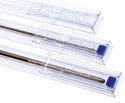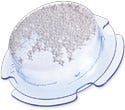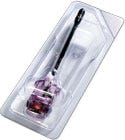The Need for Specificity in Accelerated Aging
ACCELERATED AGING
October 1, 2006
|
Materials must provide a microbial barrier over an extended period. |
Medical device manufacturers invest a great deal of time and money to ensure that their products meet both product performance needs and FDA guidelines. The selection of the appropriate packaging materials and forms is among the critical decisions that need to be made when bringing a product to market.
Manufacturers need packaging materials that provide a microbial barrier and lasting device protection over an extended period. Packaging with these benefits delivers durability and safety from the manufacturer through storage and transport to the end-user.
Accelerated aging is a critical test for documenting the expiration dates for medical products.1 It is essential to understand how to properly test materials. Using copolyester as an example, this article focuses on the conditions and requirements for proper accelerated aging.
The Need for Accelerated Aging
Consideration of key variables at the beginning of the packaging specification process is essential to guaranteeing medical packaging integrity. Aging information, including physical, thermal, and optical performance over time, is imperative for ensuring package integrity. Obtaining this information also helps to satisfy current FDA validation requirements and provide evidence of sterility and fitness-for-use over a product's life cycle.
For example, when a product needs a five-year shelf life to allow time for distribution, storage, and other constraints, the quality of the package-device combination should be monitored. Observing the effects of time through accelerated-aging studies on a product-package combination can decrease the time it takes to introduce a product in the marketplace. Material exposure to an elevated temperature for a short period of time ages a package-device combination to the same extent as would be observed were it exposed to room temperature for a longer period of time (time-temperature superposition).
|
Proper accelerated aging is necessary for ensuring product quality. |
The American Society for Testing and Materials (ASTM) has established guidelines to contribute to the reliability of materials, promote public health, and improve quality of life. Accelerated-aging testing is done based on ASTM F1980-02 standard guidelines and incorporates factors such as time at ambient (room) temperature, accelerated-aging temperature, and ambient temperature into a test equation.
Changes in relative humidity during testing away from standard laboratory guidelines of 50% rh may affect the aging results. The ASTM guidelines suggest that low- and high-humidity environments might need to be considered in testing protocols. Industry concern over relative humidity effects on physical aging has put the standard under review. Because the effects are not well known, most labs perform tests at 50% rh.
An integral part of this testing on plastics, including copolyesters, is physical aging. As a plastic is held below its glass transition (Tg) temperature, its physical properties can improve or deteriorate over time. It is essential that accelerated-aging studies be performed properly since each plastic material ages differently. Failing to perform or improperly conducting accelerated-aging testing on a medical device product–package combination can lead to incorrect data and quality issues that can affect the health and safety of end-users.
Accelerated Physical Aging
Physical aging is a process of molecular relaxation that occurs in all amorphous polymers held below their Tg temperature. Aging has been observed in polyvinyl chloride (PVC), polystyrene, styrene acrylonitrile (SAN), and polycarbonate, as well as in copolyester polymers. This discussion focuses on the effects of aging on copolyester polymers.
When a polymer is rapidly cooled to below its Tg level, which occurs in all commercial melt-phase processing techniques, it freezes into a nonequilibrium conformation with excess free volume. In an attempt to attain equilibrium, the molecular chains rearrange themselves into a denser structure, reducing the free volume of the system. Although this densification is difficult to detect, it directly affects other thermodynamic and mechanical properties that are easier to measure and can, therefore, be used to track the extent of aging over time.
These properties increase in linear fashion with the log of aging time. The aging process proceeds more quickly at higher temperatures closer to the copolyester's Tg temperature. These trends are consistent with other similar viscoelastic molecular relaxation processes, such as rheological behavior. As with other relaxation processes, time and temperature can relate through the principle of time-temperature superposition. Molecular motions that occur over a given period of time at one temperature are equivalent to motions that occur over a longer time period at lower temperatures. Simply stated, an elevated temperature acts as a catalyst for the rate of motion.
Accelerated Aging of Copolyesters
Copolyester plastics possess excellent final application properties such as long-term clarity and toughness. Using accelerated-aging testing on copolyesters that are used in medical packaging helps manufacturers to capitalize on these benefits. The ASTM guidelines suggest using an accelerated aging (Q10) factor of 2.0 as a conservative estimate for aging the packaging and device. The guidelines also state that each material, such as polycarbonate, PVC, and copolyester, has a unique Q10 factor. The appropriate Q10 factor can and should be used if it is derived from proper research and experimentation.
A number of trials were conducted to induce accelerated aging on Eastar 6763, a copolyester used in rigid medical packaging. These examples were designed to illustrate the effects of overaging when the wrong Q10 factor is used. After extensive experimentation, it was determined that the Q10 factor for copolyesters is 9.8. The examples demonstrated that using the wrong Q10 factor can drastically alter the outcome and reliability of accelerated-aging testing. Q10 factors should be determined experimentally for various polymers.
Examples
The following example illustrates how using the wrong Q10 factor ages plastic longer than may be intended. Aging a copolyester package five years (43,800 hours) at 60°C before performing shipping validation testing with the Q10 set at 2.0 inadvertently ages the material well past the intended five years. Using the ASTM equation t23 = tT × Q10 ((T–T23)/10) leads the manufacturer to deduce that the accelerated-aging time duration will be 3370 hours (140 days). Experimentation has shown that this process ages the copolyester almost 2000 years. Based on this error, the packaging would not withstand additional testing.
However, by using the correct Q10 value for copolyester and taking relative humidity and aging temperature into consideration, the accelerated-aging testing can be accurately completed in just 92 hours with reliable results.
Because of time-temperature superposition, it is possible to generate data as a function of time at different temperatures and then shift the data together on one common master curve. Numerous tests were conducted to determine the mechanical and thermal properties of copolyesters as a function of aging time and temperature.
|
Table I. (click to enlarge) Accelerated physical aging data of copolyester Eastar 6763. |
Time-temperature superpositions were performed on the data generated from these experiments to create master curves for each material. Table I shows the times and temperatures that can be used to perform accelerated-aging experiments. A product-package combination is aged at an elevated temperature for a short period of time to simulate aging at a lower temperature for an extended period of time.
For example, using the Q10 factor of 9.8 for copolyester, one hour at 60°C is equivalent to 96 hours at 40°C or 4700 hours at 23°C. Likewise, one hour at 40°C equals 48 hours at 23°C. Therefore, if manufacturers want to simulate the performance of a package after 10 years of life (87,600 hours) at 23°C, it should be aged at either 50°C for 180 hours or 60°C for 19 hours. This aging protocol reasonably represents the lifetime of a typical copolyester application.
|
|
Correct aging information helps satisfy FDA validation requirements for packaging. |
Aging copolyesters at higher temperatures for longer periods of time is not generally recommended. For example, aging for 250 hours (10 days) at 60°C is equivalent to aging for 1.2 million hours (133 years) at room temperature of 23°C. Aging for this length of time or longer at 60°C may age the material too long and could provide an unrealistic expectation of properties and aging at standard room temperature conditions.
The recommended aging conditions for copolyesters are 50°C and 50% relative humidity. At these conditions, 18 hours is equivalent to 1 year of actual aging at room temperature of 23°C. Therefore, 92 hours of aging at accelerated conditions is equivalent to 5 years of actual aging at room temperature.
Results
The testing shows that copolyester provides the required package integrity for a minimum of five years if good manufacturing practices are followed during extrusion, forming, package design, and sterilization, and if the packaging is stored at room temperature under normal conditions and humidity levels.
Conclusion
Packaging materials must provide a microbial barrier and lasting device protection over an extended period of time. Accelerated aging for all plastics is critical for understanding and documenting expiration dates. Proper testing is essential to maximize the benefits of copolyesters.
Glenn Petrie is market development manager, medical packaging, for Eastman Chemical Co. (Kingsport, TN). He can be e-mailed at [email protected].
Reference
1. Patrick J Nolan, “Common Mistakes in Validating Package Systems,” Medical Device & Diagnostic Industry 28, no. 5 (2006): 112–120.
Copyright ©2006 Medical Device & Diagnostic Industry
About the Author(s)
You May Also Like





.png?width=300&auto=webp&quality=80&disable=upscale)

